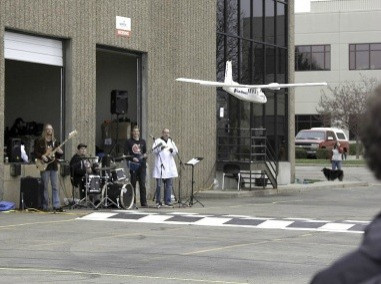DIY Drones: Francis Fukuyama's The End of History Now Involves Consumer-Class Warfare [VIDEO]

Predator drones and other unmanned aerial vehicles (UAV) like them, have become old hat in the defense sector. They were first implemented for surveillance purposes before the US involvement in the '90s Balkan wars. The spy-planes apparently became so commonplace in the 15-20 years since, it's OK for Obama to joke about using them to destroy the Jonas brothers:
But as new technologies usually do, the potentials of unmanned aircraft dripped downhill. Consumer-class and DIY drones have gained momentum in the case of hobbyists and pragmatists alike. People across the U.S. and around the world are building UAVs for fun and function.
While some might recall The Empire Strikes Back in considering these devices, others see a practical use. Beyond the joy in technical oddity, the UAVs bring to many, most consumers use helicopters, planes and multicopters for aerial photography. The largest forum on www.DIYDrones.com--an online UAV support community--has about 1700 threads under its multicopter heading. UAVs are extremely accessible.
For what it is, it's pretty cheap, David Gapen, manager of the science/industrial surplus warehouse The Reuseum in Boise Idaho, said. That's why it's becoming so popular: they're a pretty simple construction. We have a design set for our RUG [reprap user group] labs, open-source designs. Here's an example to print out and put together--if you have access to a 3D printer. Of course Gapen, who runs construction workshops and his shop and in a nonprofit Hackerspace, does. We print them out all the time, he said.
Francis Fukuyama, noted historian and author of the culturally divisive The End of History, has also been working on prototype UAVs for some time now. He chronicled his development from helicopter to multicopter in a fairly detailed blog. Fukuyama writes at the top: I have always wanted to have my own drone that could send back a live video feed. This is partly inspired by products like the AeroVironment RQ-11 Raven, which is currently in use by the US military, and which you can view in action here. The Raven is basically just a glorified RC airplane, with a sophisticated landing system that allows it to be recovered by a soldier without great pilot skills (which is one reason they cost around $35,000 each).(Fukuyama could not be reached for comment.)
Here's some video from his drone-mounted Sony Flip Cam, complete with sultry elevator jazz:
This seems to be the common goal of UAVs. In most instance the result is pretty innocuous. But some amateur surveyors are using the devices toward more altrusitic, practical means. For one example, an animal rights group called SHARK (Showing Animals Respect and Kindness) was using a multicopter to film a live pigeon shoot in South Carolina, reported the Orangeburg-based Times and Democrat. IBTimes was able to reach that group's founder and president Steve Hindi.
In S. Carolina, it is illegal to abandon an animal, Hindi, who at one time was actually a shark hunter, said. Many of these pigeons don't die when they get shot. In escaping they can take days or weeks to die.
Hindi and his crew flew a drone over the shoot at Broxton Bridge Plantation, a canned hunt club, to gather evidence from the sky. At some point, gunners unrelated to those involved in the hunt shot down the SHARK drone. In Hindi's opinion, the authorities were categorically opposed to use of the drone.
The plantation had an entire security force of police, he said. They had no time or respect for what had happened.
SHARK filed a police report about the shooting incident, but Hindi doesn't have much hope for any support from authorities.
The crafty Fukuyama, too, noticed the impetus of the entire situation as mostly socio-political. He pops in some underhanded theory, calling out the U.S. government's war on tech, at the bottom of his post:
I don't have to spell out the implications of this. I want to have my drone before the government makes them illegal. The US has been fighting such low-tech enemies lately that we haven't thought through the nature of a world in which lots of people have sophisticated drones, not just other countries but private individuals. One somewhat worrying thing is that virtually all of this equipment comes from China or Taiwan.
Despite all the theater I think it's a good thing to learn about these, Gapen said. In effect, I think technology is technology, despite government use constantly overreaching its bounds. If Google built a robotic car with a gun on it, it would be just as scary. But they're not scary because they're using it to make maps.
Here is the raw video of the UAV being shot down and the SHARK's team subsequent taunting of the shooters (skip to ~3:10):
© Copyright IBTimes 2024. All rights reserved.





















